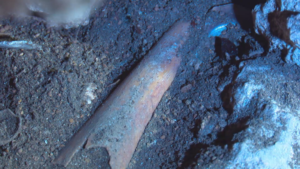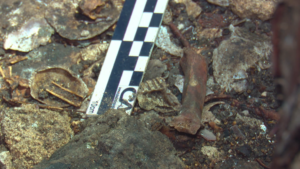ARQUEÓLOGOS CANADIENSES Y CUBANOS HALLAN RESTOS DE COMUNIDADES ABORÍGENES EN MATANZAS.
Un equipo de investigadores halló en una cueva de la zona arqueológica del Río Canímar en la ciudad de Matanzas nuevos vestigios de la presencia de las comunidades aborígenes en la zona. Entre las piezas figuran fragmentos de cráneos, fémur, costillas, así como varias partes de animales como peces.
El panel de expertos de las universidades de Winnipeg, Canada y Matanzas, el Museo Antropológico Montané y el Grupo de Investigación y Desarrollo de la Dirección Provincial de Cultura encontró los restos óseos humanos en la espelunca, durante una prospección que realizan en la región. Así lo precisó a Tv Yumurí la bio arqueóloga Yadira Chinique de Armas.
La bioarqueóloga, Yadira Chinique De Armas encabeza el estudio por la Universidad de Winipeg. Explica que entre los fragmentos de restos óseos humanos encontrados en la cueva se encuentran cráneo, fémur y costillas.
El proyecto concibe durante tres años la exploración y visita a los sitios arqueológico reportados con anterioridad en el Río Canímar .
La jefa de la investigación, doctora Silvia Hernández Godoy, informó sobre las principales acciones. Entre ellas citó la topografía y evaluación del estado del área arqueológica.
A la entrada de la cueva los especialistas realizaron una prospección para conocer particularidades del terreno. En el mismo lugar hallaron en la década del 60 del pasado siglo esqueletos de varios individuos prehispánicos.
En las márgenes del Río Canímar existe una decenas de cuevas. En parte de ellas se han encontrado restos humanos de la comunidad aborigen. El cementerio prehispánico a cielo abierto más importante del país está en el sitio Canímar Abajo.
El historiador de la ciudad de Matanzas, Ercilio Vento Canosa, destaca la importancia del área para la arqueología cubana y la historia de las comunidades indígenas de Cuba.
Los restos encontrados por la observación se dejaron en la cueva. Mientras a los identificados mediante la prospección, que es un estudio en un fragmento del terreno, se les realizarán pruebas para determinar fechas y otras particularidades.
El Río Canímar demuestra su impronta como hábitat de las comunidades que nos antecedieron. Los arqueólogos y un grupo multidisciplinario de especialistas volverán a la cueva para excavarla y revelar los misterios y las huellas de nuestros antepasados.
CANADIAN AND CUBAN ARCHAEOLOGISTS FIND REMAINS OF ABORIGINAL COMMUNITIES IN MATANZAS.
A team of researchers found new vestiges of the presence of Aboriginal communities in the area in a cave in the archaeological zone of the Canímar River in the city of Matanzas. Among the pieces are fragments of skulls, femur, ribs, as well as various parts of animals such as fish.
The panel of experts from the Universities of Winnipeg, Canada and Matanzas, the Anthropological Museum Montané and the Research and Development Group of the Provincial Directorate of Culture found the human skeletal remains in the area during a survey carried out in the region. This was pointed out by Tv Yumurí bio archeologist Yadira Chinique de Armas.
The bioarchaeologist, Yadira Chinique De Armas leads the study by the University of Winipeg. He explains that fragments of human skeletal remains found in the cave include skull, femur and ribs.
The project conceives for three years the exploration and visit to the archaeological sites previously reported in the Canímar River.
The head of the research, Dr. Silvia Hernández Godoy, reported on the main actions. Among them he mentioned the topography and evaluation of the state of the archaeological area.
At the entrance of the cave the specialists carried out a survey to know the terrain. In the same place they found skeletons of several prehispanic individuals in the 60’s of last century.
On the banks of the Canímar River there are dozens of caves. In part of them human remains of the Aboriginal community have been found. The most important pre-Hispanic open pit cemetery in the country is in the Canímar Abajo site.
The historian of the city of Matanzas, Ercilio Vento Canosa, emphasizes the importance of the area for Cuban archeology and the history of the indigenous communities of Cuba.
The remains found by observation were left in the cave. While those identified by prospecting, which is a study on a fragment of the land, will be tested to determine dates and other particulars.
The Canímar River shows its imprint as habitat of the communities that preceded us. Archaeologists and a multidisciplinary group of specialists will return to the cave to excavate it and reveal the mysteries and traces of our ancestors.
Agencies/TVYumuri/Internet Photos/Ricardo Rodríguez/Arnoldo Varona/TheCubanHistory.com
THE CUBAN HISTORY, HOLLYWOOD.



 CANADIAN AND CUBAN Archaeologists find remains of aboriginal communities in Matanzas. (Photos). + ARQUEÓLOGOS CANADIENSES Y CUBANOS hallan restos de comunidades aborígenes en Matanzas. (Fotos).
CANADIAN AND CUBAN Archaeologists find remains of aboriginal communities in Matanzas. (Photos). + ARQUEÓLOGOS CANADIENSES Y CUBANOS hallan restos de comunidades aborígenes en Matanzas. (Fotos).





